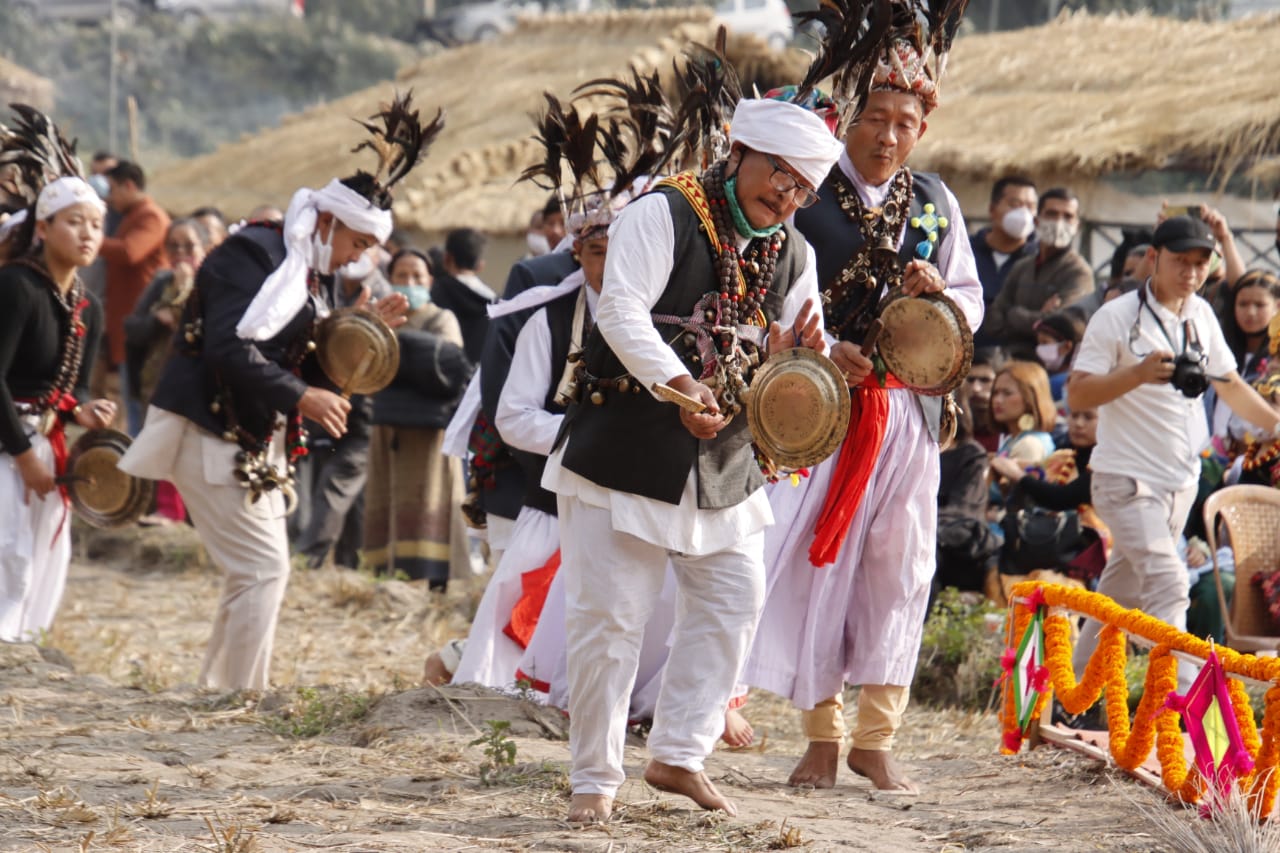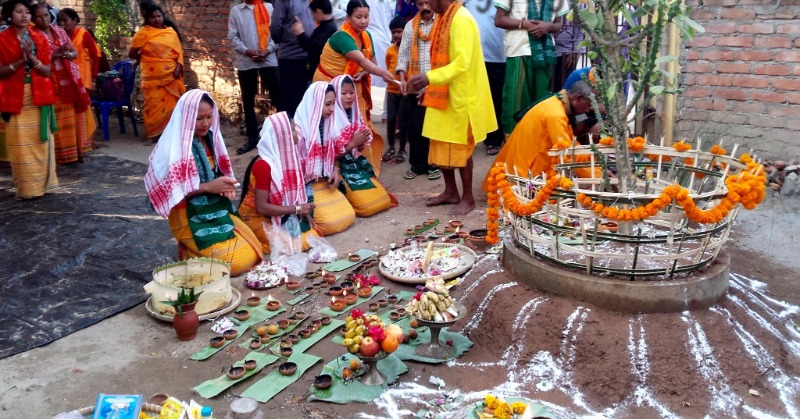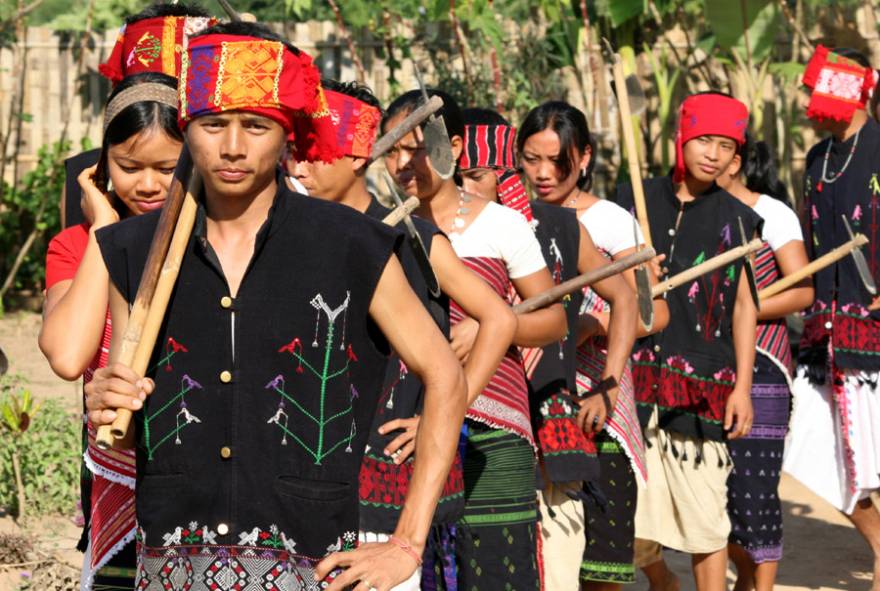By Sandhya Subba (Singzango)
The Yakthung/Limbus are one of the autochthons of Sikkim. The Limbu (exonym) or Yakthung (endonym) are indigenous tribe of the Himalayan region of Eastern Nepal, Sikkim, hill districts of West Bengal, Assam, Northeastern States, and Bhutan having a distinct culture, traditions, language, and religion. The expression Limboo, Limbu, Subba, Tsong and Yakthungba are all known to be same tribe as per Govt. of Sikkim notification No. GOS/ 32/SJE&WD/WD/2018. H.H. Risley in the “Gazetteer of Sikkim, 1894” (reprinted in 1973, page 2) says that the country between the Arun and the Kankaya was originally populated by the Limbu. The district lying on the Eastern bank of the Arun and extending up to Sikkim is known as Limbuana. (Ibid, p38). The Limbus and the Lepchas were the oldest inhabitants between the Tamra and the Kosi up to the Mechi. Most of the Limbus and the Lepchas settled in Sikkim State were the oldest inhabitants of the area. (The Limbus, Dr. Charu Chandra Sanyal, Ch1, p7).
Yakthung/Limbu people have their own distinct traditions, common ancestral, social, cultural, and religious practices inherited from their ancestors and carried forward by the present generations and preserved for the future generations. The ethno-group shared common heritage, myth, history, legacy, language, cuisine, dressing style, rituals, and customs. They claim themselves the descendants of Mujingna Kheyongna. They have scripts and language which is known as, “Yakthung pa:an” (Limbu language). The script commonly used and accepted is called “Sirijanga script.” They have a distinct religion of their own known as “Yuma Samyo.” Reciting Mundhum and performing rituals based on it, is the integral part of Yakthung/Limbu tradition. The Mundhum of the Yakthung/Limbu is addressed as almighty “Tagera Ningwaphumang” and she is believed to be omnipotent, omnipresent, infinite, omniscient and eternal. She is also worshipped in her earthly form as a household deity, “Yuma Sam” (spirit of Yuma). The Limbu people are animist and nature worshippers and do not practice any kind of idol worship.
Yakthung/Limbus are addressed by different titles, “Tsong, Yakthung, Subba, Limbu and Limboo.” Yakthung is derived from the term, “Yok” which means “place of origin” and “Tum” means “the eldest of all,” hence, gradually from “Yoktum,” it developed into Yakthung. Limbu is a term used or given after the Limbuwan. The word Limbu might have developed from the term “Lungbongba Khambongba”, the ancestors of Yakthung. Brian Houghton Hodgson prepared a manuscript during his study conducted from 1845 to 1858 on Limbu language, popularly known as “Hodgson’s Manuscript” which is still safe in British Library in London. Volume 60 of the manuscript provides us further information about how the term “Limbu” was coined.
Marriage customs:
The Mundhum is an oral and social history that prevails in Limbu communities. It guides and directs the faith, social customs, rituals, cultures, and traditions of Limbu/Yakthung. Marriage is the most important social rituals in every community. The Limbu regard marriage as an important and sacred ceremony. A family is constituted only out of a valid marriage and only members of such families can enjoy the right to property, inheritance, and succession. The parents of the boy will engage intermediators to find out a bride for their son. When bride is selected, the consent of the bride’s parents and of the girl must be obtained and offering of Loong Yang follows. This is when a sum must be offered by the bridegroom to the bride in presence of the relatives of the boy and girl. This ceremony marks the formal engagement of the boy and girl.
At least a day or two before the day fixed for marriage, the bride groom must reach the house of the bride and bring back the bride to his own house, where she will be sheltered in an out-house constructed for the purpose. This is the Heem Leeng (entry ceremony) of the bride. The relatives and parents will bestow blessings upon the groom and bride, applying Sbuabbo Fung- rice mixed with curd. This will be applied on the forehead of the groom and bride by their parents and close relations, who will bless the couple. In the Heem Leeng ceremony, the bride, and her party along with that of the bridegroom will enter the house of bridegroom, where the formal marriage ceremony must be performed by the Limbu priest (Phedangma) by reciting mantras from the Mundhum in presence of the distinguished Tumyehangs (wise elders).
In the first instance, the father of the boy takes a Mijak, Chakmak, a small knife-like iron implement without blade, which is used to make fire by striking a white stone and a metal coin. He must make and oath in the name of almighty Tagera Ningwaphumang, saying, “I (his own name) do hereby promise that from today onwards accept (name of the bride) as my own daughter-in-law. Whatever be the circumstances, I shall never ill-treat her, in case of my failure to stick to my own oath, ruin may befall upon me”. So, saying, he will strike against the rupee coin three times and thereafter hand over the Mijak and the coin to his wife. The mother-in-law takes a similar oath by striking the Mijak. Then comes the turn of the groom. He also strikes the Mijak against the rupee coin and say, “From today onwards I accept (name of the bride) daughter of (name of father and mother of the bride) as my wife. Whatever be the circumstances, I shall never ill-treat her. I shall remain a loyal husband and shall not take another girl as my wife as long as (name of the bride) is alive. In case of my failure to abide by oath, may Tagera Ningwaphumang, the almighty, curse me to ruin. The bridegroom will then hand over the Mijak and the coin to the bride. In case the bride returns the Mijak and the coin to the groom at any time during their married life, dissolution of marriage will take place. The Mijak and the coin are known as Chepyang. The bride also strikes the Mijak against the rupee coin and makes an oath thus: from today onwards I accept (name of the groom) my husband and his father and mother as my well-wishers. From today onwards I consider myself as one of the family members in this house and I shall take every step to please my husband and my in-laws and above all, I shall ever remain faithful to my husband. In case of my failure to abide by this oath, may Tagera Ningwaphumang curse upon me.”
When the bride visits to her father’s house after marriage, along with her party and accompanied by the groom and his party, Kepa Kitpa or Sai Mundri documents (marriage agreement) are executed between the parties in presence of Tumyahangs (wisemen or community elders). In this ceremony, the thar/clan of the wife will be changed into that of her husband and her children will belong to her husband’s thar/clan.
Prohibited Degrees:
In the Yakthung/Limbu community, no marriage can take place amongst the Sayepsas i.e., persons having common ancestors on the father’s side. With the Nelsas or maternal descendants., marriage are allowed from the fifth generation from the common maternal ancestor provided no person belongings up to the fourth generation is alive.
Polygamy and Polyandry:
Polyandry does not prevail in the Limbu community. If a man takes a second wife, during the life of his first wife; the first wife is entitled to maintenance, separate residence and can attend social and religious functions held in her husband’s family.
Inter-caste Marriage:
A Limbu can marry persons belonging to Rai and Lepcha communities, provided the latter are of the same faith. However, custom prohibits marriage of Limbu with a person of any communities or professing different faith. A change of religion will dissolve the marriage. A Limbu loses his/her caste, if he/she marries a scheduled caste girl or boy. If a Limbu marries a different caste girl, a Dal-Bhat ceremony takes place where ten Limbu Tumyahangs participate and accept Dal-Bhat from the bride, where upon she will be recognized as a Limbu. The Limbu boys and girls usually marry when they reach the age of 20 to 22 years.
Widow Marriage:
Widow marriage is prevalent amongst the Limbu community.
Divorce:
Limbu customary law permits divorce to both husband and wife. A Limbu husband and wife, both has the right to divorce his wife on grounds of immoral character, lying, betrayal and concealing the truth of extra-marital affairs. Such divorce by a husband of his wife is known as Khemjong and a divorce by a wife is called Najong. In any kind of divorce, whether Khemjong or Najong, documents are to be executed in the presence of Tumyahangs. Limbu customary law allows and divorce husband and wife to remarry, if he/she so desires. A divorced woman has no right to the property of her former husband, but children of a divorced woman do not loose their right to property of their father. Normally the father will have the right to custody of the children, unless they are infants and need the care and attention of their mother.
Inheritance:
Property will descent to the son or sons in equal shares, whether it be self- acquired or ancestral property. If the husband takes a second wife during the life time of his first wife, the first wife has every right to claim Phakmalak i.e., half the property of her husband, including separate residence, provides to the children from the husband. Certain Limbu wives possess Stridhan which they get from their parents by way of Miktok Dhan. Such property will be inherited by her legal heirs i.e., her sons. An adopted son has the same right to inherit as a natural son. If a man dies without any male heir, his property will descend to his brother’s son or collaterals. An illegitimate son or concubine has no right to inherit. A widow and an unmarried daughter will be entitled to maintenance out of the husband’s and father’s property.
Sappok Chomen/ womb worship:
The religious practice comprises prayers and worship of Mujingna Kheyongna, Kudap Sammang (nature divinities), Yuma Sammang- the household divinity, Heem Sammang or household divinities. Womb worship should be performed by the husband or parents of her husband between 6th and 9th month of pregnancy for protection of the foetus in the womb and the mother; and easy delivery of the child.
Yangdang Phongma rite:
The newly born child is not considered a member of the family until Yangdang Phongma. It is a “legal ritual of acceptance of fatherhood to induct the new child to the father’s family and clan/sub0clan for ethnicity, and naming of the newly born child. The child naming ceremony is performed on 3rd day of birth for a female child or 4th day of birth for a male child. Until this period the child is considered as a guest and not a member of the family/clan as they believe that the child in spiritual consciousness in the nominal world.
Mangenna:
It is one of the important rituals usually performed not only on child-birth but also every six months at the beginning of winter and summer. Mangenna also means an act of soul purification worship to raise one’s head high for a person feeling dejected and suffering in hardship in order to encourage him/her.
Death and Death-Rites:
The Limbu community believes in the existence of individual soul (intangible life) and returns to the origin at physical death (tangible life) of the individual to live in the Ancestor World. In course of the performance of rituals of Yum, Ningey, Sa Chama ritual, Phedangma relates the myth of Kesami and Namsami with this event while chanting the Mundhum. Depending on the types of death, the Limbu society recognizes eight types of death but the soul survives death to continue in other realms of existence. They are namely,
a) Lamboda or Sasik- death of the child in the womb or just after his or her birth before child naming ceremony.
b) Susuna- death of a child after child naming ceremony but before appearance of his or her milk teeth.
c) Tanglinghangsa’s death- death of a child after appearance of milk teeth but before shedding.
d) Sogha- a death due to suicide.
e) Sugup or Sugut- a death caused by violence or child-birth.
f) Nahang- an individual killed in a war.
g) Yok’s death- death of a servant whose lineage is unknown; and
h) Kuso Lamba- a natural death of an individual.
According, the disposal of the body (burials) death rites and soul destination differ depending on the type of death. In general, in the case of Lamboda or Sasik, Susuna and Tanglinghangsa’s death, the dead bodies are buried without any elaborate death rituals. There are no rituals to guide their soul. They are left to lead their own destinations.
There are elaborate customary rules of natural death. The unnatural deaths do not qualify to observe elaborate death rituals and thus performed overnight. Prayers and worship of the death rituals such as:
1) Chey-Sama- leading the dead body
2) Kham Ingma- breaking in to the Iksha Khambek layer for the burial, purchase of graveyard
3) Sam Lo apma- Taking out of the soul from the dead body.
4) Sam Sama- accompanying the soul journey to the ancestors of the Ancestor World.
5) Yum Niingey Nakma- terminating of transcendentalism period or transcendence from physical consciousness to spiritual consciousness.
6) Khaooma- declaring the death is no more in the tangible society.
7) Sam Sire Lam Tooma- bidding farewell to the divinities of the death.
8) Taap Sammang Sire Lammepma- bidding farewell of the nature divinities.
9) Sitongsing Kheema- accompanying soul of dead separating it from the living souls.
10) Yangrangsing Aangma Sam Sire Lammepma- bidding farewell to the incarnate divinity or non-physical guide and titular divinities of the dead shaman priests.
11) Nahen Khooma- envy and jealousy.
12) Nisa Thukma- Divination.
13) Yang Lengma- divination.
14) Sam Chooma- collection and accompanying souls of the dead.
15) Chellung Khoklung Yingma- avoiding negative effects of the ultraviolet rays of the planets.
16) Sam Phungma- Retrieving the souls.
17) Sam Lookma Yakma- collecting and putting the souls.
18) Mikwa Nangwa Sangwa- washing away the tears caused by the death of the relatives.
19) Phungwa Changma- rising the morals.
20) Heem Warumma- cleaning the death evils of the house.
21) Mee Phungma- collecting the fire.
22) Silam Sakma- blocking the death.
In Yuma Samyo, there are many rituals right from the womb to the afterlife. The belief systems are so strong that the afterlife rites are inevitable for the welfare of the souls of the dead.
Peli-Phangsam/Limbu Shamans:
The Yuma religious practitioners are collectively known as Peli-Phangsam. They are classified as Phedangma, Samba, Ya, Yeba, Yema and Ongshi. They are religious practitioners who, through trance or possession can gain intimate knowledge, transport knowledge as a mediator between almighty Tagera Ningwaphumang and Limbu/Yakthung people. The medium of communication used during the rituals is always Yakthung Pa:an/ Limbu language. It is believed that these Peli-Phangsams were trained to conduct prayers for the well-being of humans by reciting the Mundhum and to perform the rituals in the presence and supervisions of Tu Tu Tumyahang system, who are well versed in Mundhum. they officiate and perform all the life rituals and worship such as Pre-Natal womb worship, birth rituals, new born child naming, solemnize marriage weddings and death rituals. They are soul specialists, collect, retrieve the souls of the death, accompany the souls to the land of ancestors, and finally hand over to the ancestors of the clan.
The Limbu/Yakthung worship-place is known as Mang-heem. There are number of Mangheems/temples constructed in various places in Sikkim. The first Mangheem is “Mangshila Mangheem,” it was inaugurated on June 6th,1993 in North Sikkim. There is a need to preserve and promote such indigenous customs and rituals. The state and central government should recognize the customary laws and practices of indigenous people. They are in dire need of support, attention, encouragement, and protection from the larger ethnic groups before the extinction of their social customs and practices.
Sources:
1. Law Commission of Sikkim, Report (PART I) on SIKKIM CUSTOMARY LAWS AND
USAGES, p38-p44.
2.`J.R.Subba (Pondhak), Yuma Samyo (Yumaism)- A Religion Practised by the Limbu
Community; and How it differs from the Modern Religions.
3. Sandhya Subba (Singzango), Yakthung Civilization, Imbiri Yangthangwa Pumma, A collection of articles.
4. Amrita Theba, Tumyang Judiciary System in Limbu Community (A Customary Law).
5. Hitram Tilling, Yakthung Sanskarharu (Janma, Vivah ra Mrithyu).
(The author of this article is a Masters Degree holder from Delhi University and is presently employed in Power Department of the Government of Sikkim. Ms. Subba is a prolific writer and has so far published four books on Yakthung/Limbu tradition and culture.)






